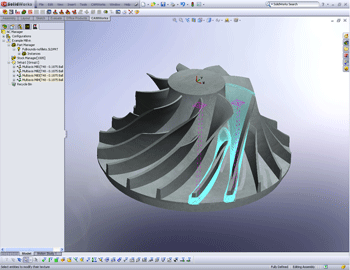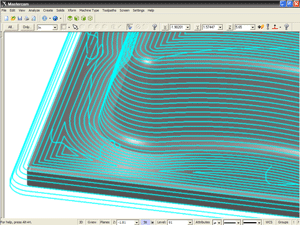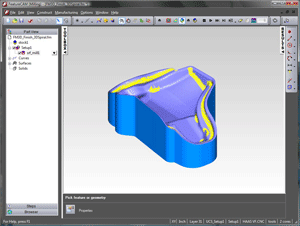- FMA
- The Fabricator
- FABTECH
- Canadian Metalworking
CAD/CAM Software
New toolpath generation techniques reduce programming time, allow the creation of complex parts in less time
- August 1, 2010
- Article
- Automation and Software
Increasing Productivity
Geometric Technologies’ new CAMWorks® 2010 release is the latest version of its solid-based CNC programming software. This new software package focuses on enhancing the machining capabilities in turning and multiaxis milling, while providing improvements to enable users to program parts faster and more easily.
“Our goal for CAMWorks 2010 was to implement numerous refinements throughout many areas of the product that will provide users with additional control and improved visualization over the NC programming process. We believe that these changes, along with support for Win 7, will result in yet an even more productive environment for users,” said CAMWorks Director of R&D Bruce Wiener.
In turning, the ability to define variable allowances along the feature provides more control, while at the same time reduces the time and complexity of programming. For turning and mill/turn machining involving irregular casting stock shapes, an STL file can now be used to represent the stock. While creating a more realistic simulation, this simplifies the stock definition and results in a more efficient and predictable toolpath, the company reports.
Improvements to multiaxis machining programming enable toolpath generation on increasingly complex part models. Also, new controls have been added to simplify the processing of impellers and blisks, while safely entering and retracting the part has become more flexible and easier than with previous versions.
Visualization enhancements have been made to feature, tooling, and stock display. These changes offer a more realistic representation of the machining environment to simplify programming and improve productivity.
In other enhancements, computation for machining time has been modified and updated to provide a more accurate estimate. This information can be used for costing and process planning purposes. Support for SQL Server Express has been added to improve performance in large-scale deployments of CAMWorks.
For more information, visit www.geometricglobal.com.
New Milling Techniques
Mastercam X5 introduces significant new capabilities, including dynamic milling techniques, multiaxis machining, and Smart Hybrid Finishing.
Dynamic milling constantly adjusts the toolpath to ensure the most efficient cut possible and allows use of the entire tool flute length, often eliminating the need for multiple-depth cuts. New dynamic milling techniques include Dynamic Rest Mill and Dynamic Contour. Dynamic Rest Mill behaves similarly to the current toolpath, only it uses dynamic milling motion instead of core mill or area mill motion for the rest operations. Dynamic Contour uses an efficient, high-speed contouring strategy to remove material along walls. It supports multipasses and can optionally include finishing passes.
The multiaxis suite has new machining techniques and a new, work flow-oriented interface. With clear illustrations the software lets the user choose the basic type of work he is doing and then gives a step-by-step process for defining how to cut the part. The multiaxis machining software also includes a highly specialized interface for smooth, gouge-free engine head porting.
New 3-D surface high-speed OptiRough toolpath generation is a new technique designed to remove large amounts of material quickly using its dynamic milling motion. Large, aggressive cuts are followed by fast, smaller up-cuts, delivering a roughed part faster than previously possible.
Hybrid finishing blends two cutting techniques in a single toolpath. This new toolpath evaluates the model shape and smoothly switches between constant Z cutting and constant scallop machining. The result is a dramatically finer finish with less work, the company states.
For more information, visit www.mastercam.com.
Feature-based CAM Programming
Delcam’ new FeatureCAM feature-based CAM system incorporates a more modern interface than previous editions, supports 64-bit computers, has improved data exchange abilities, and features new strategies for all machining types.
According to Delcam, these improvements reflect the increased investment in development of the software since its acquisition by the company in 2005.
The most obvious change for existing users is the new interface look. This incorporates a more modern icon style throughout the system, with images that more clearly illustrate the various options. They are intended to make the software even easier for new users to learn and for casual operators to use, the company reports.
FeatureCAM 2011 is the first version to support 64-bit hardware, allowing more efficient toolpath generation, especially for companies machining large or complex parts. User productivity has also been improved by extending the use of the latest multithreading technologies available in recent hardware. Improved memory management within the software gives faster calculation times, with the greatest benefits again coming when programming larger or more complex components.
Delcam’s Exchange software can be used as an additional import mechanism so that all the formats supported by Exchange can be imported into FeatureCAM. These include direct translations from systems such as CATIA® V5, Siemens NX™ and Solid Edge®, Pro/ENGINEER®, AutoCAD® Inventor®, SolidWorks®, and Rhino®, as well as support for standard formats like Parasolid, ACIS, IGES, and STEP.
The main enhancement for turning is the addition of a new style of finishing that uses separate passes to cut the faces and the diameters of the component. This approach gives a better surface finish, improved tool life, and more efficient clearance of the chips generated during the first pass over the part, state the developers.
Fully automated deburring and chamfering is now available when programming 2- or 2.5-axis parts. The ability to incorporate chamfers, even when they were not shown in the original CAD model, was added in FeatureCAM 2010. The automation of this option will allow faster programming of these finishing operations.
Another two-axis enhancement is the ability to machine parts larger than the travel of the machine tool. If the machine has a table that can index around the Z axis, the software can divide the component into pieces and generate the required series of machining operations.
Finish machining of flat areas has been made more efficient with improved detection of these surfaces. The software will then automatically adds the appropriate extra Z-level into the toolpath to give accurate finishing. This option is most beneficial for machining a series of pockets with flat bottoms at different heights.
Over recent releases, the milling capabilities within the software have been enhanced through the incorporation of strategies from Delcam’s PowerMILL system for high-speed and five-axis machining. This has continued in the 2011 version with the incorporation of the company’s patented Race Line Machining strategy. With this approach to offset machining, the roughing passes are smoothed out progressively as the toolpaths move further from the main form.
The overall result is a smoother toolpath that allows the cutter to be used at its optimum feed rate for a much larger percentage of the job. At the same time, the elimination of many sudden changes of direction reduces the rapid changes in loading that can lead to cutter breakages and damage to critical machine tool components, including the spindle. In many cases, the total length of the toolpath will also be reduced significantly, with the consequent reductions in machining times and cutter wear.
On the five-axis strategies, more options have been added to the collision avoidance functionality. These will give the user more control over the movements chosen by the software to avoid potential problems and so will help to reduce sudden changes in direction.
The 2011 release also includes improvements in the more fundamental process of five-axis drilling, with new options to program and edit five-axis hole creation, even when the items are supplied as simple circles in space rather than fully defined solids.
Finally, programming of wire EDM has been improved with the ability to work directly from solid models in a similar way to FeatureCAM’s milling, turning, and drilling options. In addition, a new automatic ordering command makes it easier to combine operations needed to produce different features, while improved control over retract moves simplifies the programming of four-axis wire EDM equipment.
For more information, visit www.delcam.com.
subscribe now


Keep up to date with the latest news, events, and technology for all things metal from our pair of monthly magazines written specifically for Canadian manufacturers!
Start Your Free Subscription- Trending Articles
- Industry Events
MME Winnipeg
- April 30, 2024
- Winnipeg, ON Canada
CTMA Economic Uncertainty: Helping You Navigate Windsor Seminar
- April 30, 2024
- Windsor, ON Canada
CTMA Economic Uncertainty: Helping You Navigate Kitchener Seminar
- May 2, 2024
- Kitchener, ON Canada
Automate 2024
- May 6 - 9, 2024
- Chicago, IL
ANCA Open House
- May 7 - 8, 2024
- Wixom, MI

















